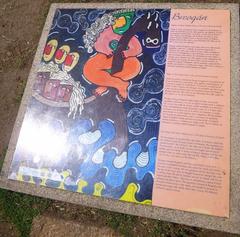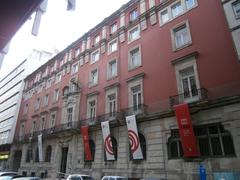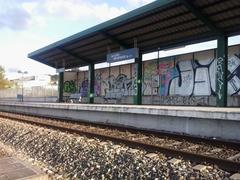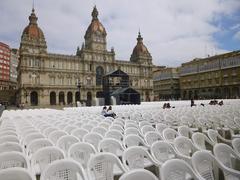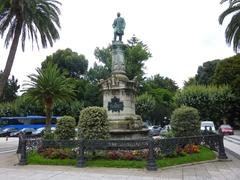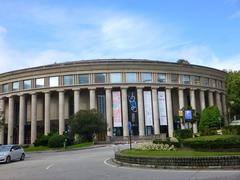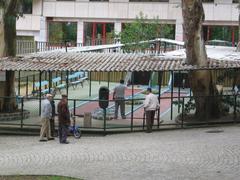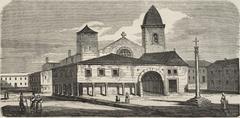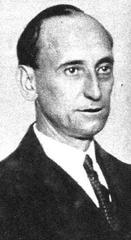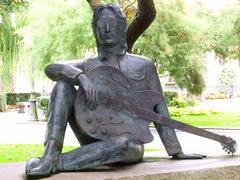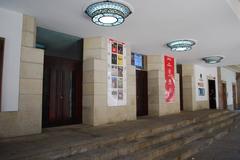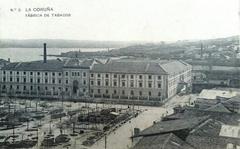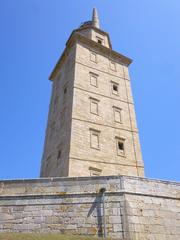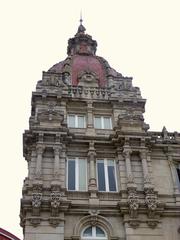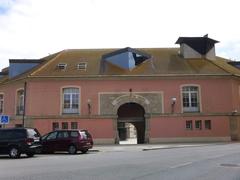
Obelisco Dos Cantóns: Visiting Hours, Tickets, and Detailed Guide to A Coruña’s Historical Landmark
Date: 04/07/2025
Introduction
The Obelisco Dos Cantóns is one of A Coruña’s most distinguished historical monuments, standing at the crossroads of Cantón Grande and Cantón Pequeño. Erected in 1895, it is an enduring symbol of the city’s modernization, civic pride, and cultural identity. This guide offers a comprehensive overview—covering its origins, architectural features, visitor information, accessibility, and practical travel tips—ensuring you make the most of your visit to this Galician landmark.
Historical Background and Urban Context
Origins
The Obelisco Dos Cantóns was conceived during A Coruña’s late 19th-century urban transformation following the dismantling of the old city walls. Its construction, initiated in 1893 and completed by 1895, was a tribute to Aureliano Linares Rivas, a prominent local politician who played a key role in the city’s development. Architect Antonio de Mesa and sculptor Gabriel Vitini led the design and artistic aspects, while José Escudero Monteagudo managed construction.
Civic Significance
Strategically located at the intersection of two major boulevards, the monument became a focal point in the newly expanded city. It quickly established itself as a central gathering place, host to civic celebrations, political rallies, and cultural events. Over the decades, the Obelisco has witnessed and reflected the evolving identity of A Coruña, serving as both a literal and symbolic meeting point for the community (Wanderlog, Audiala).
Architectural Features and Symbolism
Structure and Materials
- Height: The Obelisco stands approximately 8 meters tall, crafted from white marble with neoclassical lines.
- Base and Shaft: Its octagonal base is surrounded by landscaped gardens featuring local motifs, such as references to the Torre de Hércules. The fluted shaft draws inspiration from Egyptian and French obelisks.
- Clock and Finial: Atop the column sits a four-faced clock and a decorative weather vane featuring a model of a brigantine ship, symbolizing A Coruña’s maritime heritage.
- Decorative Details: The base is adorned with bronze reliefs and inscriptions referencing Linares Rivas, meteorological data, and heraldic symbols.
Symbolic Meaning
The monument’s verticality and classical design express aspirations of progress and unity. Its maritime motifs reflect the city’s deep ties to the sea. The use of durable, locally sourced granite and bronze underscores a commitment to both tradition and modernity (vidatos.com).
Social and Cultural Role
More than a decorative landmark, the Obelisco Dos Cantóns is a living part of A Coruña’s social fabric. Its central location makes it a favored meeting spot and a backdrop for daily life and special occasions alike. It regularly features in local festivals, such as the Feast of Saint John and María Pita Festival, and is illuminated in different colors to support various causes throughout the year.
Visitor Information
Location and Getting There
- Address: Cantón Grande, nº 11, A Coruña, Galicia, Spain (43.3683263, -8.40254848).
- On Foot: Easily accessible from major city landmarks, such as Méndez Núñez Gardens and Praza de María Pita.
- By Bicycle: Bike-friendly lanes connect to the area, with local e-bike tours available.
- Public Transport: Well-served by city buses (nearest stops: Cantón Grande, María Pita).
- By Car: Underground parking available at Cantón Grande; note temporary changes due to redevelopment (Official Municipal Website).
Visiting Hours and Tickets
- Hours: Open 24 hours, every day.
- Tickets: No entrance fee; the monument is freely accessible in a public plaza.
Accessibility
- Mobility: The area is fully accessible to visitors with reduced mobility, with flat, wide sidewalks and step-free crossings.
- Cyclists: Dedicated bike lanes and nearby bike parking.
- Ongoing Improvements: Urban redevelopment projects are enhancing step-free access and connectivity.
Travel Tips
- Best Times: Spring and summer (March–August) offer the most pleasant weather.
- Photography: Early morning or sunset provides optimal lighting for photos.
- Safety: The area is well-patrolled and generally safe, though standard precautions are advised during busy events.
- Local Customs: Respect commemorative ceremonies and events held at the monument.
Nearby Attractions
- Méndez Núñez Gardens: Historic park adjacent to the monument.
- Teatro Colón and Teatro Rosalía: Renowned cultural venues.
- Marina and Seafront Promenade: Scenic coastal walks and access to beaches.
- Historic Quarter: Explore arcaded streets, vibrant markets, and local museums.
- Tower of Hercules: UNESCO-listed lighthouse, a short distance away.
Events and Community Life
Throughout the year, the Obelisco area serves as a stage for concerts, public demonstrations, festivals, and open-air markets. Its adaptable role—solemn, festive, or political—makes it an enduring civic landmark.
Current Developments (2025)
The Cantóns district is undergoing significant redevelopment to expand pedestrian zones, improve green spaces, and enhance connectivity. While there may be temporary traffic and access adjustments, pedestrian routes to the Obelisco remain open. Stay updated via the official municipal digital map.
Frequently Asked Questions (FAQ)
Q: What are the visiting hours?
A: The monument is outdoors and accessible 24/7.
Q: Is there an entrance fee or ticket needed?
A: No, visiting is free of charge.
Q: How do I get there?
A: Easily accessible by foot, bike, public transport, or car (with nearby parking).
Q: Are guided tours available?
A: Yes, many local walking and e-bike tours include the Obelisco.
Q: Is the monument wheelchair accessible?
A: Yes, the area features step-free access and accessible crossings.
Q: Can I climb the Obelisco?
A: No, climbing is not permitted for safety reasons.
Q: When is the monument illuminated?
A: It is often lit during evenings and special celebrations.
Visuals and Media
We recommend reviewing online galleries and virtual tours for a preview of the Obelisco’s details and setting. Alt tags for images should include terms like “Obelisco Dos Cantóns A Coruña,” “Obelisco Dos Cantóns visiting hours,” and “A Coruña historical sites” to aid discoverability and accessibility.
Image alt text: Obelisco Dos Cantóns monument with surrounding garden in A Coruña
Related Reading and Resources
- Wanderlog: Obelisco Dos Cantóns in A Coruña
- Audiala: Things to do in A Coruña, Spain
- Vidatos: La historia y curiosidades del Obelisco de A Coruña
- Official Municipal Website
- Xunta de Galicia Cultural Heritage
For updated information on access, events, and redevelopment, refer to the official municipal digital map.
Conclusion
The Obelisco Dos Cantóns is much more than a historical monument—it is a living emblem of A Coruña’s heritage, community, and urban vitality. With free, all-day access, excellent connectivity, and continued urban improvements, it remains an essential stop for visitors and locals alike. Plan your visit to immerse yourself in the city’s rich narrative and enjoy the unique blend of history, culture, and daily life at the heart of A Coruña.
For more travel tips and local insights, explore related articles, download the Audiala app, and follow us on social media.





